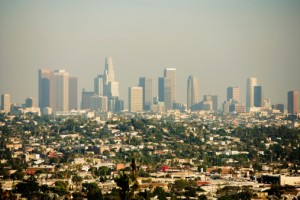SoCal Tops Smog List Again—Is Your Indoor Air Quality Affected?
Learn how to protect your indoor environment from outdoor pollutants.
 The landscape of southern California, with the mountains and foothills rolling down to the beaches of the Pacific Ocean, is undeniably beautiful. Unfortunately, this same landscape also creates airflow patterns that result in some very ugly smog being trapped over our cities.
The landscape of southern California, with the mountains and foothills rolling down to the beaches of the Pacific Ocean, is undeniably beautiful. Unfortunately, this same landscape also creates airflow patterns that result in some very ugly smog being trapped over our cities.
While LA County and southern California as a whole have made great strides towards reducing emissions and smoggy days have become fewer and less severe, we still have a problem. According to the American Lung Association’s State of the Air Report for 2015, the top 5 worst metro areas for ozone levels, year-round particulate pollution, and short-term particulate pollution were all located in California.
The Los Angeles-Long Beach area had the worst ranking for ozone, aka smog, and the 5th-worst ranking for both year-round and short-term particulate pollution. This is all despite the fact that in 2013 this area had 71.8 fewer high ozone days than in 1996 and 73.3 fewer high particulate pollution days since 2000.
In other words, the situation is getting better, but slowly. What are residents of southern California supposed to do in the meantime? This summer may be a particularly bad one for air quality, with the ongoing drought putting lots of dust from dry lands and soot from wildfires into the air, and high temperatures potentially increasing the potency of certain allergens.
The simple solution is to make sure your home is equipped to keep outdoor pollutants out to the greatest extent possible. General Heating & Air Conditioning can help with this task in several ways.
- Home Performance Testing. Before we make any recommendations as to how to improve your indoor air quality, we want to first evaluate just how much polluted outdoor air may be getting into your home in the first place. We can get hard numbers on your air loss and air incursion using special home performance tests such as blower door tests or thermal imaging. Armed with this knowledge, we can then create a whole-home plan for improving your indoor air quality.
- Air Leak Sealing. Every home needs some amount of fresh air flowing into it, but if your home has air leaks, you are going to get too much fresh air. And if this air is in reality not so much “fresh” as polluted, this is a big problem. We can help seal up air leaks, especially in your ductwork, to make sure you’re not allowing too much dirty air to come in or too much cleaned air to escape.
- HVAC Filter Upgrades. Your HVAC systems should already be equipped with a quality filter, but if you are concerned about your indoor air quality you may very well want to consider an upgrade to a filter that will capture more contaminants. We can help you consider your options.
- IAQ Equipment. Finally, we can offer a variety of equipment to support indoor air quality, such as air purifiers, air cleaners, and even germ-killing UV lamps.
If you have any concerns at all about your indoor air quality, please don’t hesitate to contact us!
